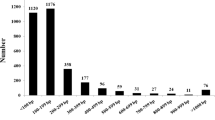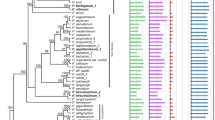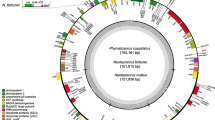Abstract
Parent-specific, randomly amplified polymorphic DNA (RAPD) markers were obtained from total genomic DNA ofChlamydomonas reinhardtii. Such parent-specific RAPD bands (genomic fingerprints) segregated uniparentally (through mt+) in a cross between a pair of polymorphic interfertile strains ofChlamydomonas (C. reinhardtii andC. minnesotti), suggesting that they originated from the chloroplast genome. Southern analysis mapped the RAPD-markers to the chloroplast genome. One of the RAPD-markers, “P2” (1.6 kb) was cloned, sequenced and was fine mapped to the 3 kb region encompassing 3′ end of 23S, full 5S and intergenic region between 5S and psbA. This region seems divergent enough between the two parents, such that a specific PCR designed for a parental specific chloroplast sequence within this region, amplified a marker in that parent only and not in the other, indicating the utility of RAPD-scan for locating the genomic regions of sequence divergence. Remarkably, the RAPD-product, “P2” seems to have originated from a PCR-amplification of a much smaller (about 600 bp), but highly repeat-rich (direct and inverted) domain of the 3 kb region in a manner that yielded no linear sequence alignment with its own template sequence. The amplification yielded the same uniquely “sequence-scrambled” product, whether the template used for PCR was total cellular DNA, chloroplast DNA or a plasmid clone DNA corresponding to that region. The PCR product, a "unique" new sequence, had lost the repetitive organization of the template genome where it had originated from and perhaps represented a “complex path” of copy-choice replication.
Similar content being viewed by others
References
Adleman L M 1994 Molecular computation of solutions to combinatorial problems;Science 266 1021–1024
Armbrust E V, Ferris P J and Goodenough U W 1993 A mating type-linked gene cluster expressed inChlamydomonas zygotes participates in the uniparental inheritance of the chloroplast genome;Cell 74 801–811
Boynton J E, Gillham N W, Newman S M and Harris E H 1992 Organelle genetics and transformation ofChlamydomonas; inCell organelles (ed.) R G Hermann (New York: Springer-Verlag) pp 3–64
Bussieres J, Lemieux C, Lee R W and Turmel M 1996 Optional elements in the chloroplast DNAs ofChlamydomonas eugametos andC. moewusii: unidirectional gene conversion and co-conversion of adjacent markers in high-viability crossses;Curr. Genet. 30 356–365
Canceill D and Ehrlich S D 1996 Copy-choice recombination mediated by DNA polymerase III holoenzyme fromEscherichia coli;Proc. Natl. Acad. Sci. USA 93 6647–6652
Dutcher S K 1995 Mating and tetrad analysis inChlamydomonas reinhardtii;Methods Cell Biol. 47 531–540
Gross C H, Ranum L P and Lefebvre P A 1988 Extensive restriction fragment length polymorphisms in a new isolate ofChlamydomonas reinhardtii;Curr. Genet. 13 503–508
Haring M A, Schuring J, Urbans A, Musgrave H. van den Ende and Farris P J 1996 Random amplified polymorphic DNA markers (RAPDs) as a tool for gene mapping inChlamydomonas eugametos;J. Phycol. 32 1043–1048
Harris E H 1989The Chlamydomonas sourcebook (San Diego: Academic press)
Ji W, Zhang X Y, Warshamana G S, Qu G Z and Ehrlich M 1994 Effect of internal direct and invertedAlu repeat sequences on PCR;PCR Methods Appl. 4 109–116
Judo MSB, Wedel A B and Wilson C 1998 Stimulation and suppression of PCR-mediated recombination;Nucleic Acids Res. 26 1819–1825
Lee C M, Kim S W, Kim S M and Sohn U 1999 DNA computing the Hamiltonian path problem;Mol. Cells 9 464–469
Lemieux C, Turmel M and Lee R W 1980 Characterization of Chloroplast DNA inChlamydomonas eugametos andC. moewusii and its inheritance in hybrid progeny;Curr. Genet. 2 139–147
Leu S 1998 Extraordinary features in theChlamydomonas reinhardtii chloroplast genome: (1) rps2 as part of a large open reading frame; (2) AC. reinhardtii specific repeat sequence;Biochim. Biophys. Acta 1365 541–544
Loewen P C and Switala J 1995 Template secondary structure can increase the error frequency of the DNA polymerase fromThermus aquaticus;Gene 164 59–63
Mets L 1980 Uniparental inheritance of chloroplast DNA sequences in interspecific hybrids ofChlamydomonas;Curr. Genet. 2 131–138
Newman S M, Harris E H, Johnson A M, Boynton J E and Gillham N W 1992 Nonrandom distribution of chloroplast recombination events inChlamydomonas reinhardtii: evidence for a hotspot and an adjacent cold region;Genetics 132 413–429
Nishimura Y, Misumi O, Matsunaga S, Higashiyama T, Yokota A and Kuroiwa T 1999 The active digestion of uniparental chloroplast DNA in a single zygote ofChlamydomonas reinhardtii is revealed by using the optical tweezer;Proc. Natl. Acad. Sci. USA 96 12577–12582
Odelberg S J, Weiss R B, Hata A and White R 1995 Templateswitching during DNA synthesis byThermus aquaticus DNA polymerase I;Nucleic Acids Res. 23 2049–2057
Saal B and Wrickle G 1999 Development of simple sequence repeat markers in rye (Secale cereale L.);Genome 42 964–972
Sager R 1954 Mendelian and non-Mendelian inheritance of streptomycin resistance inChlamydomonas reinhardtii;Proc. Natl. Acad. Sci. USA 75 356–363
Sager R and Lane D 1972 Molecular basis of maternal inheritance;Proc. Natl. Acad. Sci. USA 69 2410–2413
Sager R and Ishida M R 1963 Chloroplast DNA inChlamydomonas;Proc. Natl. Acad. Sci. USA 50 725–730
Sears B B and VanWinkle-Swift K 1994 The salvage/turnover/ repair (STOR) model for uniparental inheritance inChlamydomonas: DNA as a source of sustenance;J. Hered. 85 366–376
Tatusova T A and Madden T L 1999 Blast 2 sequences — a new tool for comparing protein and nucleotide sequences;FEMS Microbiol. Lett. 174 247–250
Turmel M, Limieux C and Lee R W 1981 Dispersive labeling ofChlamydomonas chloroplast DNA in15N-14N density transfer experiments;Curr. Genet. 4 91–97
Viswanathan V K, Krcmarik K and Cianciotto N P 1999 Template secondary structure promotes polymerase jumping during PCR amplification;Biotechniques 27 508–511
Williams J G, Kubelik A R, Livak K J, Rafalski J A and Tingey S V 1990 DNA polymorphisms amplified by arbitrary primers are useful as genetic markers;Nucleic Acids Res. 18 6531–6535
Zaphiropoulos P G 1998 Non-homologous recombination mediated byThermus aquaticus DNA polymerase I. Evidence supporting a copy choice mechanism;Nucleic Acids Res. 26 2843–2848
Zhang Z, Huang K, Zhang Y, Liu N and Yang K 1994 Interference by complex structures of target DNA with specific PCR amplification;Appl. Biochem. Biotechnol. 44 15–20
Author information
Authors and Affiliations
Corresponding author
Rights and permissions
About this article
Cite this article
Wagle, M.D., Sen, S. & Rao, B.J. Local repeat sequence organization of an intergenic spacer in the chloroplast genome ofChlamydomonas reinhardtii leads to DNA expansion and sequence scrambling: A complex mode of “copychoice replication”?. J. Biosci. 26, 583–594 (2001). https://doi.org/10.1007/BF02704757
Received:
Accepted:
Published:
Issue Date:
DOI: https://doi.org/10.1007/BF02704757




